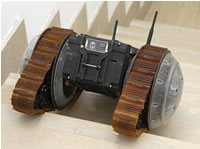

Elbit Systems is expanding its family of man portable unmanned ground systems with the introduction of two new models. During a recent exhibition the company displayed the new robots, in addition to a wide range of advanced land and C4I solutions. The new members of the VIPeR family of intelligent and portable robots include the Mini-VIPeR and Maxi-VIPeR, which join the VIPeR robot, already operational in the Israel Defense Forces under the Hebrew name “Pazit.”
All VIPeRs are designed for portability and high mobility; the robots are configurable for multiple types of missions by add-on sensors, modules and payloads, tailored to specific tasks. The Viper is controlled by a single operator, and is designed to negotiate obstacles typical of an urban environment, such as climbing stairs and rubbles, when performing surveillance, reconnaissance and support troops in urban warfare missions.
The VIPeR vehicle uses the “Galileo Wheel”, a patented wheel that can be transformed on the move into a triangular track, developed by Galileo Mobility Instruments ltd. This unique automotive system enables the robot to climb stairs, negotiate difficult terrain, move over barricades, dense vegetation and other obstacles.
The Mini-VIPeR and Maxi VIPeR robots use a more common track system. While the two new robots bear some resemblance to the Beagle, developed by Elbit Systems of America, a closer look at the two new robots reveal more similarities to the locally designed VIPeR. The larger version uses a wide, heavy duty track system, adapted from the VIPeR for outdoor operation over rugged terrain. The smaller robot uses a narrow track, more suitable for indoor operation.
Both have body mounted sensors, flat top and bottom surfaces, for the mounting of mission payloads. The Mini-VIPeR is a light-weight, one-person portable system (weighing approximately 3.5 kg), equipped with advanced sensors that allow full operation in adverse terrain. Thrown into a dark tunnel or tossed through a window, into a room, the mini-Viper allows warfighters to survey structures before entering. The larger, yet compact Maxi-VIPeR robot is designed to carry sensors and tele-operated manipulator arms, for the handling of unexploded devices and other hazardous materials including radioactive materials.

















